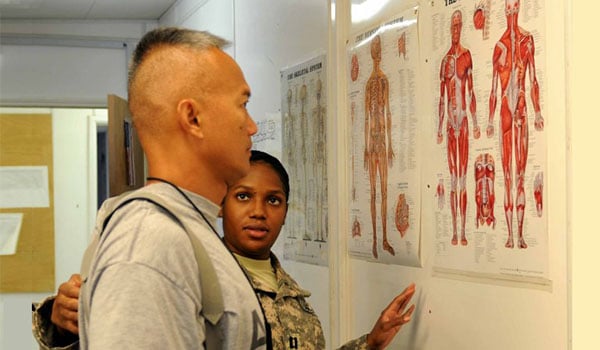
Ask the Flight Surgeon / By CPT (Dr.) Frank C. Stafford: Q: Osteopath, Chiropractor, Physical Therapist? What is the difference and who should I see?
FS: In the military, we have a wide variety of medical providers that use hands-on techniques such as stretching, gentle pressure and resistance in order to diagnose, treat and prevent illness and injury. These include osteopaths, chiropractors and physical therapists.

Photo/army.mil
Osteopaths are licensed physicians who hold a four-year medical degree of Doctor of Osteopathy and bear a “DO” after their name. This degree is earned after completing a bachelor’s degree. As with their “MD” physician colleagues, DOs have the broadest scope of practice of the medical practitioners discussed here. Both DOs and MDs generally have additional residency training beyond their medical school education and are board certified in a specialty such as family medicine, general surgery, aerospace medicine, etc. Chiropractors are designated by a “DC” for a Doctor of Chiropractic degree that is approximately 3-4 years in length after completing a bachelor’s degree. Physical therapists may have earned a DPT (Doctor of Physical Therapy) or an MPT (Masters in Physical Therapy) degree after completing college. Though chiropractors and physical therapists can decide to train further in a subspecialty, it isn’t required. Unlike DOs, DCs and DPTs are not licensed to practice in all areas of medicine, are not permitted to write for prescription medications or perform surgical procedures and focus almost exclusively on musculoskeletal concerns.
What is the difference between these medical professionals?
In general, they all take a holistic approach to assisting the body in healing itself through physical manipulations of the muscles and joints and the soft tissues around them. Osteopathic physicians are trained to perform manipulation of the joints as well as target therapies for the fascia (tissue surrounding the muscles and joints). Treatments may include gentle stretching of the fascia (similar to a massage), deeper probing of tender points on the body, traction/stretching of the joints and associated muscles and finally mobilization/manipulation of joints where cavitation’s cause “pops” that can be heard with the treatment.
Typically, chiropractors focus on using spinal joint manipulation to improve spinal nerve function to the body. Manipulations typically include small, high velocity, low amplitude (HVLA) thrusts into the joints. The thrust is not traumatic or aggressive and is typically tolerated well. This is usually called “adjusting.” Some chiropractors will involve soft tissue work as described above as well as include core exercises, muscular exercises and other activities similar to what a physical therapist would use.
Physical therapists typically focus on muscular rehabilitation, reducing pain, preventing disability and promoting the ability to move. They work to increase strength, endurance and balance between muscle groups. This may involve treatments such as electrical stimulation, ice therapy and dry needling. Some physical therapists may perform mobilization, where they stretch the joints, as well as manipulation where they thrust into the joint. Due to differences in training and scope of practice, as well as practitioner preference, you may have different experiences depending on the type of provider seen.
Who should I see?
Musculoskeletal injuries may require medication, stretching, suturing or even surgical intervention. Osteopaths can provide all these services while both chiropractors and physical therapists are limited to non-invasive techniques. However, it is not uncommon that some conditions will require a team effort. Studies on low back pain as well as other pain syndromes have consistently demonstrated a synergy between manipulation or adjusting and physical therapy. Manipulation/adjustment helps the immediate area to regain its regular motion with some studies demonstrating a reduction in muscular tension of the affected area. Physical therapy complements the previous techniques by providing muscular training that improves strength, endurance and balance between affected areas and the rest of the body to support and maintain the motion that was returned. These combined interventions decrease the frequency and intensity of pain episodes, minimize down time, and help patients return to their usual activities sooner.
How does my flight surgeon participate in this type of care?
Musculoskeletal injuries and pain syndromes are distracting and can limit aviator functionality in flight. To address these concerns and help mitigate aeromedical risk, your aeromedical provider can coordinate referrals to an osteopath or chiropractor, if they do not already perform OMT themselves, and to physical therapy. You will be monitored by your aeromedical provider to assess the progress of your treatment and your ability to participate in flight duties.
Fly Safe!
Questions?
If you have a question you would like addressed, email it to This email address is being protected from spambots. You need JavaScript enabled to view it..”>This email address is being protected from spambots. You need JavaScript enabled to view it.. We will try to address it in the future. See your unit flight surgeon for your personal health issues. The views and opinions offered are those of the author and researchers and should not be construed as an official Department of the Army position unless otherwise stated.
CPT Frank C. Stafford, DO, DC, MPH is a flight surgeon at the United States Army School of Aviation Medicine.










